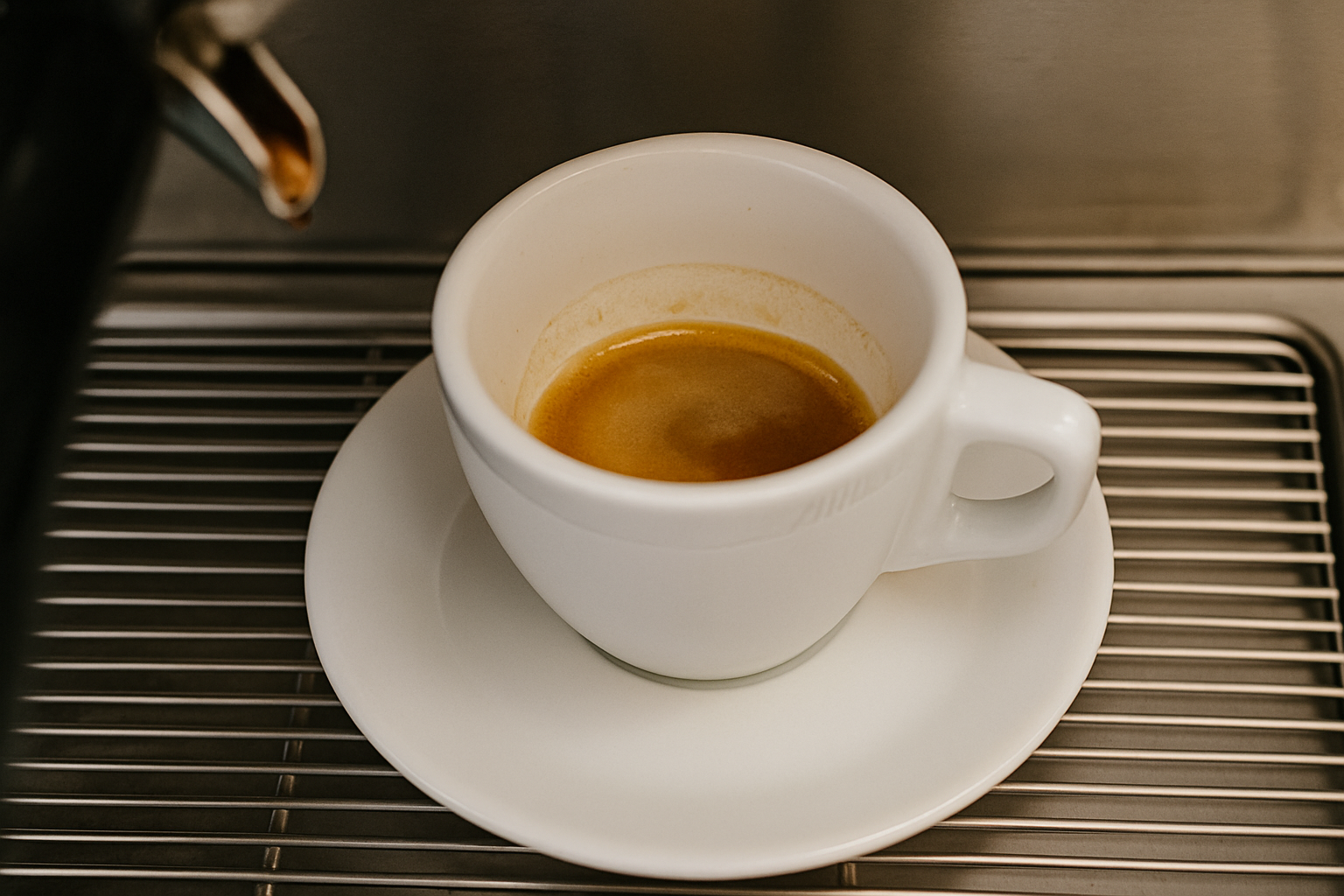You’ve dialed in the grind. Your tamp feels solid. The shot looks fine — but when you taste it, something’s off. It’s weak, watery, and lacking that bold espresso punch. Sound familiar?
For beginner baristas, diluted or weak espresso is one of the most frustrating problems. You followed all the steps, yet the flavor isn’t there. The good news? Weak coffee is usually caused by a few fixable mistakes in the extraction process or preparation routine.
In this article, you’ll learn why espresso sometimes comes out tasting thin or weak, and what you can do to fix it — consistently.
What Does “Weak” Espresso Actually Mean?
A weak espresso doesn’t just mean “not strong.” It usually refers to a shot that lacks:
- Body – It feels thin or watery in the mouth
- Flavor intensity – It tastes flat, dull, or empty
- Balance – It might be sour or bland instead of rich and complex
- Aroma – It smells faint instead of bold and fragrant
Even if the crema looks decent, a weak shot reveals deeper issues with extraction, dose, grind size, or even milk preparation (if you’re making milk-based drinks).
Let’s go through the most common reasons why this happens — and how to fix them.
Mistake #1: Grind Size Too Coarse
Grind size has a direct impact on extraction. If your grind is too coarse, water will rush through the coffee puck too quickly and won’t extract enough flavor.
Signs your grind is too coarse:
- Shot time under 20 seconds
- Pale, fast-flowing espresso
- Little to no crema
- Sour or watery taste
Solution:
- Adjust your grinder to a finer setting, one step at a time
- Aim for a 25–30 second extraction time for a double shot
- Watch for a slow, steady stream (like warm honey) with rich crema
A proper grind unlocks the full potential of the coffee — from sweetness to body to aroma.
Mistake #2: Under-Dosing the Coffee
Using too little ground coffee in the portafilter is a common beginner error. Even if the tamp and timing are right, you’re not giving the water enough coffee to extract from.
Signs of under-dosing:
- Weak flavor even with correct timing
- Low crema volume
- Shots taste diluted, no matter what you change
- Puck looks wet and sloppy
Solution:
- Weigh your dose — aim for 18–20g for a standard double shot, unless your machine or basket is calibrated differently
- Use the correct portafilter basket for your dose size
- Don’t eyeball it — even 1 gram can make a big difference in flavor
Consistency in dosing equals consistency in quality.
Mistake #3: Tamping Too Soft
Tamping compresses the coffee bed, increasing resistance and promoting even extraction. A light tamp leads to low resistance — and the water zips right through without doing its job.
Signs of a light tamp:
- Fast, uncontrolled shot flow
- Weak body and aroma
- Puck breaks apart easily after extraction
Solution:
- Apply firm, even pressure when tamping — around 13–15 kg (30 lbs)
- Focus more on consistency and levelness than brute force
- Make it part of your muscle memory every time you prep a shot
A proper tamp gives your shot the structure it needs.
Mistake #4: Channeling in the Coffee Puck
Channeling is when water finds weak spots in the coffee puck and flows through them instead of evenly saturating the whole bed. The result? Parts of the coffee get under-extracted — leading to a thin, weak taste.
Common causes:
- Uneven tamping
- Poor coffee distribution
- Cracks or air pockets in the puck
- Bumping the portafilter before inserting it into the group head
Solution:
- Distribute your grounds evenly before tamping — use a finger swipe, WDT tool, or distribution tool
- Tamp evenly with a level surface
- Avoid knocking or shaking the portafilter after tamping
- Inspect your pucks — if they’re crumbling or cracked, there’s a problem
Clean technique = clean extraction.
Mistake #5: Letting the Shot Run Too Fast
Even with the right dose and grind, if your water runs through too quickly, your shot won’t extract enough flavor. Quick shots usually mean the coffee wasn’t given enough time to bloom and develop depth.
Ideal shot time:
- 25–30 seconds for a standard double
- Anything under 20 seconds often results in under-extraction
What to do:
- Adjust your grind finer
- Check for channeling
- Verify your dose and tamp
- Time your shots every shift (don’t guess)
Speed is great — but only when it doesn’t ruin your coffee.
Mistake #6: Old or Stale Coffee Beans
No matter how skilled you are, bad beans = bad coffee. If your beans are too old, the espresso will lack oils, crema, and flavor.
Signs of stale beans:
- Dull or dusty smell
- Weak aroma during grinding
- Thin, bubbly crema
- Lifeless flavor
Best practices:
- Use beans within 2–4 weeks of roast date
- Store them in an airtight container, away from light and heat
- Avoid pre-ground coffee for espresso — it stales much faster
- Don’t overload the grinder hopper — rotate fresh beans daily
Fresh beans give you more to work with — period.
Mistake #7: Incorrect Brew Ratios
The brew ratio refers to how much liquid espresso is produced from a specific dose of coffee. If you extract too much liquid, the shot becomes diluted.
Example:
- Using 18g of coffee and pulling 50g of espresso in 15 seconds = watery shot
- Correct ratio: 18g in, 36g out over 25–30 seconds for a 1:2 ratio
What to do:
- Use a scale to measure both your dose and yield
- Stick to a 1:2 or 1:2.5 ratio depending on the desired strength
- Avoid “eyeballing” the shot based on volume alone — crema and foam can deceive
Precision is the difference between average and excellent espresso.
Mistake #8: Not Preheating Equipment
If your portafilter, cup, or espresso machine group head is cold, it will steal heat from the water and lower your extraction temperature — resulting in flat, under-extracted coffee.
Signs:
- Lukewarm espresso
- Thin crema
- Lacking body and intensity
How to fix:
- Preheat cups with hot water
- Always insert the portafilter back into the machine between shots
- Let the machine fully warm up before starting your shift
- Run a blank shot (no coffee) through the group head to warm it up
Heat is essential for a full-bodied shot.
Bonus: Weak Milk Drinks? It Might Not Be the Espresso
If your espresso tastes fine on its own, but your latte or cappuccino seems weak, the issue might be with the milk.
Possible causes:
- Too much milk dilutes the espresso flavor
- Overheating the milk reduces sweetness and texture
- Watery milk (low-fat or skim) doesn’t hold flavor as well as whole milk
Tips:
- Use the right amount of milk for each drink
- Stick to 60–65°C (140–150°F) for ideal sweetness
- Practice microfoam — silky milk blends better and preserves espresso notes
Your milk should complement, not hide, the espresso.
Final Thoughts: Strong Espresso Starts with Strong Fundamentals
Weak coffee isn’t a mystery — it’s a sign that something went wrong. The best baristas don’t just follow steps blindly. They diagnose, adjust, and learn from every shot.
If your espresso is consistently tasting watery or thin, use this checklist to troubleshoot:
- Is your grind fine enough?
- Are you using enough coffee?
- Is your shot running too fast?
- Are your tools and equipment preheated?
- Are you tamping evenly and consistently?
Start with the basics, then fine-tune as you go. Mastering espresso takes time, but every weak shot is a learning opportunity.
Soon, you’ll not only fix your mistakes — you’ll prevent them before they happen.

Marcelo Rodrigues is a passionate barista with over 7 years of experience in specialty coffee. He’s worked in top cafés, led barista training sessions, and now shares practical tips to help beginners and coffee lovers improve their skills. Through this blog, Marcel makes the world of coffee more accessible—one cup at a time.

